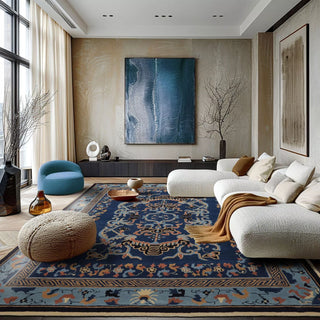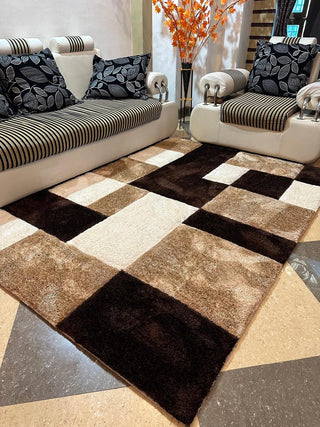Layering rugs has become quite the trend in living rooms because it offers depth, textures, and styles that one cannot simply resist. Besides being aesthetically pleasing, this design method gives room for mixing various colors, shapes, and designs to create an individualistic look. You can go for either a specific focus point or a bold statement when layering rugs into your living room. This blog will guide you through the art of layering rugs while suggesting ways of doing it right. If you want to try out this look but unsure of where find suitable carpets, just go ahead and buy carpet online.
Why Layer Rugs in Your Living Room?
Layering rugs is more than just a design trend—it’s a functional and stylish way to enhance your living room. Here are some key benefits:
- Adds Visual Interest: Mixing different rugs creates a layered look that’s rich in texture and personality.
- Defines Spaces: If you have an open floor plan, layering rugs helps to define different areas, such as seating or reading zones, within your living room.
- Boosts Comfort: Doubling up on rugs adds an extra layer of softness underfoot, making your living room feel cozier and more inviting.
- Flexible Style: You can easily switch out the top rug for a new color or pattern when you want a quick style refresh.
If you’re considering this technique, there are a few important things to keep in mind when you buy carpet for living room online for layering.
Step 1: Choose a Base Rug
The base rug is the foundation of your layered look, so it’s essential to choose the right one. The base rug should be large enough to anchor your furniture. For most living rooms, this rug should cover the majority of the floor space and sit beneath all major furniture pieces. A neutral base rug in shades of beige, gray, or cream provides versatility, allowing you to easily layer a smaller, more vibrant rug on top. A flat-weave or low-pile rug works best as a base since it won’t compete with the top layer and allows the focus to remain on the design above. Before you buy carpet online, measure your living room and determine the ideal size for your base rug. A well-sized base rug sets the stage for the layering process.
Step 2: Select a Top Rug with Bold Patterns or Colors
The top rug is where you can get creative. This layer is your chance to introduce patterns, colors, or textures that bring character to your living room. If your base rug is solid or neutral, the top rug can feature bold patterns such as stripes, geometrics, or florals. This contrast adds visual interest and depth. Pick a top rug in colors that complement your living room’s existing decor. For example, if your sofa is navy, consider a top rug with hints of blue to tie the look together. The top rug should be smaller than the base rug. It can be centered within the seating area or offset for a more casual, layered effect.
Step 3: Experiment with Textures
Mixing textures is one important element in successfully layering rugs. A dynamic look can be made when different materials are combined into one design. By placing a soft wool rug over a robust jute or sisal rug, it creates a sense of equilibrium between coziness and roughness at the same time. It is possible to add a touch of luxury and contrast by layering a flat-weave carpet with an opulent, fluffy piece. When cotton, linen or bamboo are used as natural fibers they lend themselves to an organic-earthy environment that is fashionable yet functional.
Step 4: Consider the Shape and Layout
Layering rugs isn’t limited to rectangular shapes. Playing with different shapes and layouts can enhance the overall design. Placing a round rug over a rectangular base rug is a chic way to break up the straight lines in your living room and create a more dynamic visual flow. Don’t be afraid to angle the top rug or position it slightly off-center. This asymmetry adds a modern, laid-back feel to your space. If you have a large living room, you can layer multiple smaller rugs to create a patchwork effect. Overlapping them slightly will give the space a more cohesive look.
Step 5: Secure Your Rugs
When layering rugs, it’s essential to keep them in place to avoid tripping hazards or bunching. Invest in good-quality rug pads that provide grip and prevent slipping. They also add extra cushioning for a more comfortable feel. For smaller rugs that may move around easily, double-sided carpet tape is a quick and effective solution. Positioning furniture like sofas or coffee tables on top of the rugs can help secure them and keep everything in place.
Step 6: Ensure Harmony in Your Living Room Decor
To create a look that is diverse yet cohesive, you need to be sure that whatever layering of area rugs you do is skillful. To avoid overwhelming and chaotic vibes, even contrasting patterns should not go beyond the same color scheme. If you are using layers of rugs on top of each other, make sure to use a solid or muted color underneath a patterned one. Bohemian, modern or traditional – ensure the layered rugs blend with your room’s decor theme perfectly.
Conclusion
The layering of rugs in the living room is a design trick that can easily be adapted, adding to the style, comfort and warmth of your space. Using a base rug and a top one that is well thought out, texture experiments as well as shape diversifications can result into a one-of-a-kind inviting place. The ability to buy carpet online makes it possible for you to find out what is available; then create various kinds of combinations you prefer. Whether you want something very bold or just to give it a little enhancement layering them, then rug will change the entire look of the traditional house.



